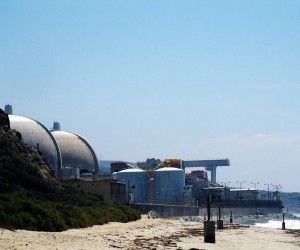Why green power won’t replace nukes
by Wayne Lusvardi | December 17, 2014 8:47 am
 Last year Southern California Edison mothballed[1] its 2.3 gigawatt San Onofre Nuclear Generating Station. As CalWatchdog.com reported at the time, the actual reason probably was mechanical defects[2] caused from retrofitting the plant to ramp up and down rapidly to back up erratic green power.
Last year Southern California Edison mothballed[1] its 2.3 gigawatt San Onofre Nuclear Generating Station. As CalWatchdog.com reported at the time, the actual reason probably was mechanical defects[2] caused from retrofitting the plant to ramp up and down rapidly to back up erratic green power.
The Environmental Defense Fund and other green advocates[3] now are celebrating that California is replacing the loss of that nuclear power with solar and wind power, electricity storage, energy efficiency and peak-load curtailments. The California Independent System Operator, which runs the grid, proposed to procure 50 percent[4] of that lost power from “preferred resources,” meaning anything but fossil fuels.
However, the reality is San Onofre generated 2.2 gigawatts of clean energy, while Edison is only looking to replace that with 46 megawatts of green power — about 1/40th of San Onofre’s prior generating capacity. The rest of the load will shift to natural-gas power.
The reason: All electrons do the same work, but don’t arrive at the same time. San Onofre’s power was constant, 24/7. Wind and solar are unpredictable.
Here is the breakdown of Edison’s procurement to replace San Onofre’s power for the West Los Angeles area:
Southern California Edison Energy Procurement to Replace San Onofre
| Source | Megawatts | Percent Total |
| New gas-fired generation | 1,698 | 76.7% |
| Behind-the-meter storage[5] | 160.6 | 7.2% |
| Energy Efficiency | 135.2 | 6.1% |
| In Front of the Meter Storage[6] | 101.0 | 4.5% |
| Demand-Response[7] | 75.0 | 3.4% |
| Behind-the-Meter Solar Renewable[8] | 46.0 | 2.1% |
| Total | 2,216 megawatts (2 gigawatts) | 100% |
| Source: Southern California Edison, Local Capacity Requirement Request for Offers for West Los Angeles-Moorpark Sub-Areas[9]. | ||
Fossil fuels
So 76.7 percent of the power to replace San Onofre is coming from new fossil-fuel natural gas-fired electric generating plants.
Ironically, according to The Carbon Brief, studies from Europe show “gas power costs twice as much if it only runs half the time.”[10] That’s because it costs money to just ramp up and ramp down power plants.
Not all of Edison’s procurement is to replace lost power from San Onofre. Edison also must replace 17,500 megawatts of power lost from the retirement[11] of six other coastal power plants. The retirement is needed to comply with requirements to shift from using ocean water to cool steam plants to air-cooled systems in order to protect fish larvae.
The plants to be retired are: Humboldt Bay 1 and 2, Potrero, South Bay, Morro Bay 2 and 4 and Contra Costa 6 and 7.
Why new power must be sited in Orange County and L.A.
According to AES California[12]:
“AES Southland is currently developing plans to replace its existing natural gas power plants in Long Beach, Huntington Beach and Redondo Beach with modern, more attractive and far more efficient facilities, which will take up less space at the sites. Modern and more flexible natural gas plants are critical to integrate renewable energy into the electric grid and help California meet its important clean energy goals.
“Our plans to redevelop our power plants will increase the local taxes we pay, and allow us to continue providing jobs, doing business with local merchants, and supporting these communities through our charitable giving.”
Why must the new power plants be located close to customer bases in Orange and Los Angeles counties? For several reasons:
First, voltage[13] is like water pressure in a hose. San Onofre created enough voltage to “pressurize” the power grid so that electrons would flow smoothly.
By contrast, green power cannot provide much, if any, voltage because it is not consistently available to the power grid 24/7. It’s like taking a shower where the water cycles on for 1 minute, then off for 3 minutes.
Second, to prevent any future big transmission line outages, called an “N-1-1 event.”[14] N-1-1 means the number of transmission lines (N) that are lost in a catastrophic event is 1 and 1, or 2. Edison must plan for two transmission lines going down simultaneously.
The problem with two lines being out of commission at once is overload that could create a cascade of shutdowns throughout the entire state grid.
Third, the Duck Chart Problem, which CalWatchdog.com detailed last month[15]. Basically, the Duck Chart shows there is a demand in California to ramp up 13,500 megawatts of conventional power in a narrow two-hour window of time at sunset each day to replace solar power going offline. That would be enough power for about 6,750,000 homes per hour.
The imported electrons are the problem because they must be transmitted on transmission lines that may be out of service in a catastrophic N-1-1 event. So local power sources are preferred.
Fourth, the old Encina Power Plant[16] in Carlsbad has been shut down and is being retrofitted for an ocean water desalination plant and new co-generation natural gas power plant.
- mothballed: http://articles.latimes.com/2013/jun/07/local/la-me-ln-edison-closing-san-onofre-nuclear-plant-20130607
- mechanical defects: http://calwatchdog.com/2014/01/03/scientist-says-no-reason-to-shut-down-san-onofre-nuke-plant/
- advocates: http://blogs.edf.org/energyexchange/2014/03/18/cpuc-singing-the-right-tune-on-songs-but-southern-california-still-needs-to-harmonize-to-achieve-a-clean-energy-future/
- 50 percent: http://www.chadbourne.com/files/Publication/cfad8f58-cecf-4c6c-8aee-f05b88a09a27/Presentation/PublicationAttachment/94741763-0080-4041-b229-f0a51beaa053/AdditionalPowerSoCal_Oct13.pdf
- Behind-the-meter storage: http://www.sunwindandwater.org/Behind_meter_settlement.html
- In Front of the Meter Storage: http://www.sunwindandwater.org/Behind_meter_settlement.html
- Demand-Response: http://www.pge.com/en/mybusiness/save/energymanagement/whatisdr/index.page
- Behind-the-Meter Solar Renewable: http://www.sunwindandwater.org/Behind_meter_settlement.html
- Local Capacity Requirement Request for Offers for West Los Angeles-Moorpark Sub-Areas: https://www.sce.com/wps/portal/home/procurement/solicitation/lcr/!ut/p/b1/hdDBboMwDAbgV-FejZhmonAMK4MgNNZRqSyXKrA0RIKkSlh5_dGpu22db5Y-W_6NGGoQ0_yiJJ-U0Xy49iw8FnRLguxxTaskSIHUNNqmeQp1FS7gfQHwRxH4b_6A2D3yVIY3EEQZyWkNFDZlDDR5fUvjfYyjDb6BOIM0Lyqg2X6HgeIdvNSEYICfDXeOLBCTg2mXwIcEsXCVr9r5Go3oFkcSMStOwgrr98ZNqJnn2ZfGyEH4nRl_c05w2_VnbvnoUOPM59QLq72OD-pkrFbcEx_KGe1pMXuSO08KLez309F5bEDRB_Z8KckXhg5TCw!!/dl4/d5/L2dBISEvZ0FBIS9nQSEh/
- “gas power costs twice as much if it only runs half the time.”: http://www.carbonbrief.org/blog/2014/10/five-weird-things-about-the-eus-cost-of-energy-study/
- retirement: http://www.energy.ca.gov/renewables/tracking_progress/documents/once_through_cooling.pdf
- AES California: http://www.aescalifornia.com/new-projects
- voltage: http://science.howstuffworks.com/electricity7.htm
- “N-1-1 event.”: http://www.caiso.com/Documents/SCE_Proposal-ContingencyModelingEnhancements.pdf
- detailed last month: http://calwatchdog.com/2013/11/08/will-warren-buffetts-hydro-prevent-ca-electricity-crisis-part-1/
- Encina Power Plant: http://carlsbaddesal.com/desalination-plant
Source URL: https://calwatchdog.com/2014/12/17/why-green-power-wont-replace-nukes/